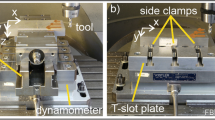Abstract
Large aluminium monolithic parts used in the aeronautic industry frequently show significant geometric distortions after the machining process. These distortions are the consequence of the initial residual stresses of the raw material as well as machining-induced residual stresses. Therefore, to minimise distortions, it is fundamental to understand the effect of the different parameters of the manufacturing process and define the optimum manufacturing strategy. This work studies the effect of initial residual stresses of aluminium plates and the residual stresses generated by the machining process on the final geometric distortions of the part. First, 7175-T7351 aluminium bars (40 mm wide × 38 mm thick × 400 mm long) were face milled at two different cutting conditions reducing the thickness to 6 mm. The distortions were measured in a coordinate measuring machine. The results revealed that the machining strategy significantly influenced the distortions, as a difference of 65% on distortions was found between the two cutting conditions. In addition, an FEM model to predict distortions was developed. This model considers initial residual stresses (measured by the contour method) and residual stresses induced by the machining process (measured by the hole drilling technique). Once the FEM model was validated, the study was extended to more complex geometries. These new studies revealed that final distortions are sensitive to machining-induced residual stresses. Furthermore, this finding indicates that it is possible to define machining conditions which generate desirable residual stress profiles to minimise part distortion.
Similar content being viewed by others
References
Sim WM (2009) Residual stress engineering in manufacture of aerospace structural parts. Filton, UK: Airbus SAS, wwwtransport-researchinfo. Accessed 20 Sep 2017
Li JG, Wang SQ (2016) Distortion caused by residual stresses in machining aeronautical aluminum alloy parts: recent advances. Int J Adv Manuf Technol 89(1–4):997–1012. https://doi.org/10.1007/s00170-016-9066-6
Masoudi S, Amini S, Saeidi E, Eslami-Chalander H (2015) Effect of machining-induced residual stress on the distortion of thin-walled parts. Int J Adv Manuf Technol 76(1–4):597–608. https://doi.org/10.1007/s00170-014-6281-x
Brinksmeier E, Sölter J (2009) Prediction of shape deviations in machining. CIRP Annals-Manuf Technol 58(1):507–510. https://doi.org/10.1016/j.cirp.2009.03.123
Denkena B, Dreier S (2014) Simulation of residual stress related part distortion. In: Denkena B (Ed), Proceedings of the 4th Machining Innovations Conference, Hannover, Germany, pp 105–113
Cerutti X, Mocellin K (2015) Influence of the machining sequence on the residual stress redistribution and machining quality: analysis and improvement using numerical simulations. Int J Adv Manuf Technol. https://doi.org/10.1007/s00170-015-7521-4
Denkena B, De León-García L, Köhler J (2006) Influence of high performance cutting operations on the residual stresses of aluminum structural work-pieces. In: Grant I (ed) Proceedings of ICAS 2006, 25th International Congress of the Aeronautical Sciences, Hamburg, Germany
Tang ZT, Yu T, Xu LQ, Liu ZQ (2013) Machining deformation prediction for frame components considering multifactor coupling effects. Int J Adv Manuf Technol 68(1–4):187–196. https://doi.org/10.1007/s00170-012-4718-7
Li B, Jiang X, Yang J, Liang SY (2015) Effects of depth of cut on the redistribution of residual stress and distortion during the milling of thin-walled part. J Mater Process Technol 216:223–233. https://doi.org/10.1016/j.jmatprotec.2014.09.016
Yang Y, Li M, Li KR (2014) Comparison and analysis of main effect elements of machining distortion for aluminum alloy and titanium alloy aircraft monolithic component. Int J Adv Manuf Technol 70(9–12):1803–1811. https://doi.org/10.1007/s00170-013-5431-x
Huang X, Sun J, Li J (2015) Finite element simulation and experimental investigation on the residual stress-related monolithic component deformation. Int J Adv Manuf Technol 77(5–8):1035–1041. https://doi.org/10.1007/s00170-014-6533-9
Prime MB (2000) Cross-sectional mapping of residual stresses by measuring the surface contour after a cut. J Eng Mater Technol 123(2):162–168. https://doi.org/10.1115/1.1345526
Grant PV, Lord JD, Whitehead PS, Fry TA (2005) The application of fine increment hole drilling for measuring machining-induced residual stresses. Appl Mech Mater 3-4:105–110. https://doi.org/10.4028/www.scientific.net/AMM.3-4.105
Jayanti S, Ren D, Erickson E, Usui S, Marusich T, Marusich K, Elanvogan H (2013) Predictive modeling for tool deflection and part distortion of large machined components. Procedia CIRP 12:37–42. https://doi.org/10.1016/j.procir.2013.09.008
Bi YB, Cheng QL, Dong HY, Ke YL (2009) Machining distortion prediction of aerospace monolithic components. J Zhejiang Univ Sci A 10(5):661–668. https://doi.org/10.1631/jzus.A0820392
Wan M, Ye XY, Zhang WH (2017) Theoretical prediction of machining-induced residual stresses in three-dimensional oblique milling processes. Int J Mech Sci 133:426–437. https://doi.org/10.1016/j.ijmecsci.2017.09.005
Berruti T, Lavella M, Gola MM (2009) Residual stresses on Inconel 718 turbine shaft after turning. Mach Sci Technol 13(4):543–560. https://doi.org/10.1080/10910340903451472
Acknowledgments
The authors would like to thank Naieli Zabala for writing assistance.
Funding
The authors thank the Basque and Spanish Governments for the financial support given to the projects HDAUTO (EC_2016_1_0015) and TEMPROCEN (CIEN_IDI-20141299).
Author information
Authors and Affiliations
Corresponding author
Rights and permissions
About this article
Cite this article
Madariaga, A., Perez, I., Arrazola, P.J. et al. Reduction of distortions in large aluminium parts by controlling machining-induced residual stresses. Int J Adv Manuf Technol 97, 967–978 (2018). https://doi.org/10.1007/s00170-018-1965-2
Received:
Accepted:
Published:
Issue Date:
DOI: https://doi.org/10.1007/s00170-018-1965-2




